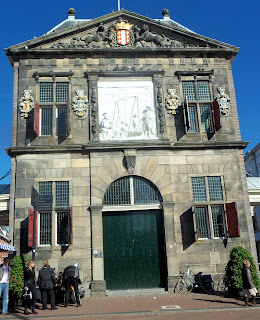The history of this house and its art collection is interesting enough in itself, but Maurtitshius famously contains Johannes Vermeer's renowned painting "Het Meisje met de Parel" (Girl With A Pearl Earring), painted circa 1666. The pearl girl has become the icon for The Hague itself, and you can find reproductions of it on everything from flags to umbrellas to mouse pads.
Mauritshuis
This is it. That little bitty (17.5" × 15") oil painting on wood is what all the hoopla is about.
But after you've actually seen the painting in person, you begin to realize that you've come away with something undefinable that you didn't have before you saw it. You have changed ever-so-slightly, simply through the experience of being in its presence.
Mauritshius also houses one of the largest collections of Rembrandts anywhere. Here's just a sampling:
Rembrandt's last self portrait, painted in 1669, the year he died.
Rembrandt's father, Harmen van Rijn, painted in 1631.
Andromeda Chained to the Rock, 1631. The model is probably Rembrandt's wife, Saskia van Rijn.
A young self-portrait of Rembrandt with armor, painted in 1629.
Portrait of Amsterdam Mayor Jan Six, a friend and patron of Rembrandt, painted in 1654.
Portrait of Aeltje Uylenburgh (aged 62 years) completed in 1632. Aeltje Uylenburgh was the prosperous cousin of Saskia Uylenburgh van Rijn, Rembrandt's wife.
The Anatomy Lesson of Dr. Nicolaes Tulp (16 January 1632)
Rembrandt was 26 years old when he painted this.
Rembrandt was 26 years old when he painted this.
Remember, this is a sampling of the Rembrandt paintings at Mauritshaus.























































